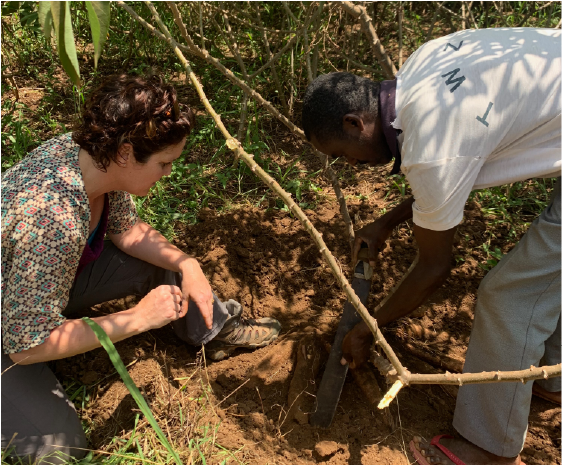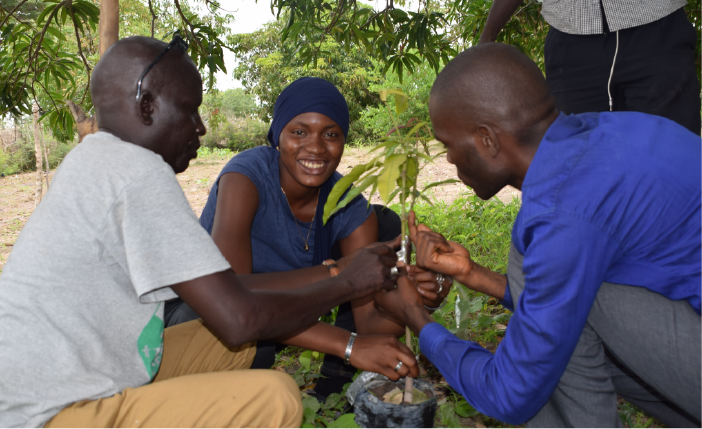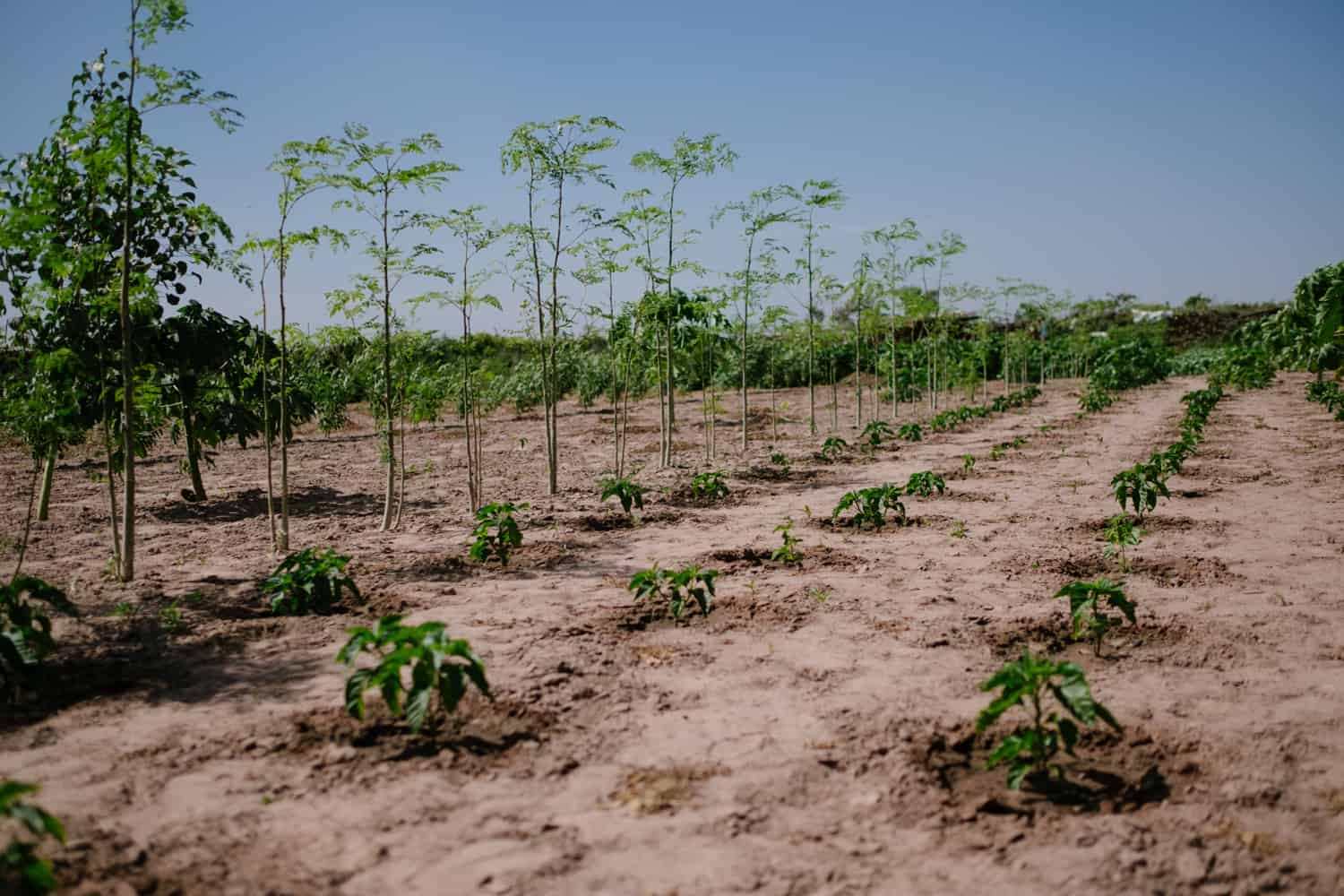Because of this increased awareness, our donors, partners, and ambassadors we have been able to launch 15 new projects in early 2019 alone! With more than 4,800 new farmers in our program we will plant 15 to 20 million trees this year and hope to plant even more each consecutive year. Their Forest Gardens will plant farmers, and their families, out of poverty and hunger reaching over 42,000 people in total.
Ensuring Sustainable Growth
These project additions were made possible through donor and partner support and are a part of our sustainable growth strategy aimed at developing 125,000 Forest Gardens and helping 1 million people by 2025. We are dedicated to running these projects efficiently and sustainably. We are diligently providing knowledge through training, and the supplies and equipment new project farmers need to succeed.
We recently brought Brandy Lellou on board, our Director of Programs, she is overseeing the incredible work happening on the ground. She has overseen our training of trainers seminars and has helped in the hiring of technicians for each project to ensure farmers have everything the need to be successful. TREES’ Ashleigh Burgess has recently stepped into the role of Deputy Director of Program Quality and Implementation where she has enhanced our data collection and coordination between Trees for the Future staff and Forest Garden Farmers.

As you read this, Trees for the Future staff in each of our program countries are hard at work training technicians and farmers in the Forest Garden Approach.
Keep an eye out for updates on all of these new projects including stories about farmers, Trees for the Future staff, and our regularly scheduled Training of Trainers. And before you know it, we’ll be sharing pictures of graduation day and farming families’ improved health, income, and quality of life!

Introducing Trees for the Future’s Latest Projects
Kenya – 2 New Projects
Kenya Country Profile: Agriculture dominates Kenya’s economy. 15–17% of Kenya’s total land area has sufficient fertility and rainfall to be farmed. The Kenyan government is currently working with public and private stakeholders to reach their target of 10% tree cover for the country – a large increase from the current 6.2%. Critical in meeting this goal is agroforestry. Our Forest Garden Projects will not only contribute to this massive landscape initiative, but help smallholder farming families improve sustainable farming practices and increase their food security. We are currently working in two counties in Kenya along trade corridors, Homa Bay County on the border of Lake Victoria and Kiambu County, north of Nairobi.
New Projects:
Homa Bay 2 – 580 farmers & 4,199 beneficiaries
Homa Bay is located along the southern shore of Lake Victoria’s Winam Gulf, about 420 square kilometers West of Nairobi. Homa Bay has one of the largest populations afflicted with HIV at 25% of the county’s population, increasing the need for nutrition.
Despite its proximity to Lake Victoria, inland water resources are scarce and farmers rely on rain fed agriculture. The soils are generally poor and degraded due to soil erosion and years of poor farming practices. Most farms have less than five tree species and tree cover of less than 3%. With the success of Trees for the Future’s Homa Bay 1 project, TREES identified enough interested neighboring farmers and farmers groups to start two more Homa Bay projects.
Homa Bay 3 – 500 farmers & 3,500 beneficiaries
Homa Bay is located along the southern shore of Lake Victoria’s Winam Gulf, about 420 square kilometers West of Nairobi. Homa Bay has one of the largest populations afflicted with HIV at 25% of the county’s population, increasing the need for nutrition.
Despite its proximity to Lake Victoria, inland water resources are scarce and farmers rely on rain fed agriculture. The soils are generally poor and degraded due to soil erosion and years of poor farming practices. Most farms have less than five tree species and tree cover of less than 3%. With the success of Trees for the Future’s Homa Bay 1 project, TREES identified enough interested neighboring farmers and farmers groups to start two more Homa Bay projects.
Tanzania – 4 New Projects
Tanzania Country Profile: Tanzania is a large country with a vast array of climates and natural resources. With an annual output of about 90,000 tons of Sunflower seed oil, Tanzania is one of the top ten sunflower oilseed producers in the world. One area of our current Forest Garden projects lies in the sunflower belt of central Tanzania in the Singida region. Tanzania is also the top third tobacco producer in Africa. The second area of our Forest Garden projects lies to the east in the Tabora region. Most of our participant farmers in these semi-arid environment used to make money solely from sunflowers and tobacco resulting in a lack of diversity in food and cash crops and leading to increased deforestation. Thanks to the Forest Garden Approach, we are teaching farmers in these regions how to become climate resilient and diversify their landscapes.
New Projects:
Singida 2 – 300 farmers, 2,100 beneficiaries
Tumuli is along Singida Mwanza main road, farther northwest than Singida town and Iguguno. Farmers in this area have typically 4 acres of land and commonly grow crops, such as sunflower, maize, and onions. People in this area are relatively poor and rely on subsistence farming for their livelihood.
Singida 3 – 275 farmers, 1,925 beneficiaries
This project is located in Siuyu ward in Ikungi districts in Singida region, about 17km Singida town. The ward is comprised of 3 Villages: Siuyu, Makhotea and Unyankhanya. As other parts of Singida, Siuyu ward is dominated by Nyaturu tribe who are both farmers as well as animal keepers. Other tribes include Nyiramba and Iraq (Wambulu). Nearly every household keeps local chickens for both cash and domestic use. Other livestock include cattle, goats, sheep and donkeys.
Tabora 1 – 581 farmers, 4,339 beneficiaries
This project is taking place in the Urambo and Uyui districts, where most residents depend on rain-fed small-scale farming, practices that are highly vulnerable to environmental degradation and the effects of climate change. Tabora is famous for tobacco growing and beekeeping (honey and beeswax). However massive deforestation has occurred as farmers cut trees to smoke tobacco. The cutting of flowering trees in turn impacts bee production. Livestock farming is also an important economic activity in the region.
Tabora 2 – 500 farmers, 3500 beneficiaries
Mabama is to the west of the town of Tabora. In Tabora region, rapid population growth has placed enormous pressure on natural and environmental resources. Tabora is also famous for tobacco growing, beekeeping (honey and beeswax) and timber activities. Livestock farming is also an important economic activity in the region. Farmer groups consist of a range of ages with younger farmers focused on vegetable production for market sales and older farmers interested in staple crops to feed their families.
Cameroon – 3 New Projects
Cameroon Country Profile: Cameroon is a Central African country located on the Gulf of Guinea with a great diversity of peoples, landscapes, and wildlife. Cameroon’s landscape challenges range from deforestation and desertification in the semi-arid North to threatened biodiversity in the mountainous forested areas of the West. While these areas once held some of the highest concentrations of biodiverse fauna and flora in Africa, deforestation and mining of resources from the forest have resulted in destroying the habitat that these species need for survival; including critically endangered mammals, birds, amphibians, and reptiles. In addition, the local population depends on these resources for food and income. Clear-cutting of forests for agricultural and timber exploitation has contributed to erosion and loss of nutrient-rich top soils, and diminished ground and potable water quality. We will expand centrically around three critical biodiversity hotspots that connect Mt. Baboutous, Mt. Nlonko, and the Western Highland Plateau. We have evaluated these areas as having the most need and are the most suitable for the Forest Garden Approach.
New Projects:
Mount Bamboutas – 113 Farmers, 791 Beneficiaries
The mountains here have been 90% stripped of trees. Water quality is a huge concern and protecting water catchment areas is the primary focus here. We are working at the base of the mountain to develop forest gardens with farmers that act as green buffers around the water catchment areas. Farmers are being trained to grow indigenous trees, non-forest timber products, medicinal trees, fruit and spice trees that were previously harvested from the forest. This aims to reduce the pressure on the mountain by training farmers to grow products to eat and sell.
Nlonako – 48 Farmers, 336 Beneficiaries
This area is home to the Giant Frog and the primary focus of conservation efforts. The reptiles of Mt Nlonako is the most species rich single-locality area in reptilian fauna in Africa. TREES is working with farmers in this landscape to plant forest gardens near existing indigenous forest as buffers to prevent further deforestation and pressure on the forest and amphibian habitat.
Western High Plateau – 205 Farmers, 1,435 Beneficiaries
The densely populated Western High Plateau has the greatest land degradation problems in all of Cameroon. Factors responsible for this include climate change, the hilly nature or topographic layout of the land, and human interference through overgrazing, destructive agricultural practices and the impact of deforestation. The inhabitants of high-density infertile, rugged mountainous areas resort to intensified land exploitation that leave little room for soil regeneration. TREES is working in this landscape to plant forest gardens with a conservation focus on improving soils in the region. Farmers are being trained to grow indigenous trees, nitrogen fixing trees, non-forest timber products, medicinal trees and fruit trees.
Senegal – 6 New Projects
Senegal Country Profile: Senegal is the largest international hub and economic center in West Africa, but much of its population lives in rural farming communities on less than $1 a day. According to 2012 data from the UN World Food Program 2012, Senegal is chronically vulnerable to natural disasters (particularly drought and flooding), its agricultural sector has declined over time, it imports about 46% of its food requirements, its groundwater table is falling 20 feet per year in many places, and it is vulnerable to food price spikes. We see incredible impact in Senegal with the Forest Garden Approach. We have the most projects in this country- 2 have graduated, 6 are existing projects, and 6 are new projects. We currently work in two counties in the Kaffrine region, Kaffrine County and Koungheul County. We have two graduated projects, 6 existing projects and 6 new projects in this region.
New Projects:
Kaffrine 7 – 339 Farmers, 4,068 Beneficiaries
The wild success of Kaffrine 3, based in Nganda, spurred us to start an additional project just to the west of Nganda near the Ndankou Forest. Nganda is s small town 25 kilometers south of Kaffrine which gets a little more rain than their neighbors to the north.
Kaffrine 8 – 287 Farmers, 3,444 Beneficiaries
Kaffrine 8 is in the same location as the Kaffrine 1 project that previously graduated but with new participants. Building off of successes of Kaffrine 1, we will work with the neighbors of graduates of the Forest Garden Training Program to expand Forest Gardens across the zone.
Kaffrine 9 – 389 Farmers, 4,668 Beneficiaries
This project is uniquely made up of women’s groups who live north of the town of the Kaffrine. In recent years, Trees for the Future has begun integrating village savings and loan activities into Forest Garden projects across Senegal. These activities have been wildly popular, especially among women. This project aims to help organize nearly 300 women in groups to build on savings activities by planting Forest Gardens and increasing crop sales.
Kaffrine 10 – 250 Farmers, 3,000 Beneficiaries
This project is on the border of Gambia to the west, kaffrine 3 to the east and kaffrine 8 to the northeast. It includes 12 villages divided into 12 groups with 250 farmers. This area is suitable for agriculture and market gardening. The inhabitants of this area practice traditional agriculture and livestock farming. The flow of products will be easy, the Gambian and Senegalese merchants buy in large quantities at the border to sell in the interior. from the country.
Kaffrine 11 – 250 Farmers, 3,000 Beneficiaries
Kaffrine 11 is also on the border between the Gambia, the previous graduated Koungheul 1 project, and aligned with the Kaffrine project10. It includes 15 village where livestock and agriculture are the main activities.
Koungheul 3 – 202 Farmers, 2,424 Beneficiaries
The town of Koungheul lies on a main road that stretches from east to west across Senegal. This project takes place south of the road, from the town of Koungheul to the border with the Gambia. The zone is very arid and seasonally food insecure. This is the third project Trees for the Future has started in Koungheul.
